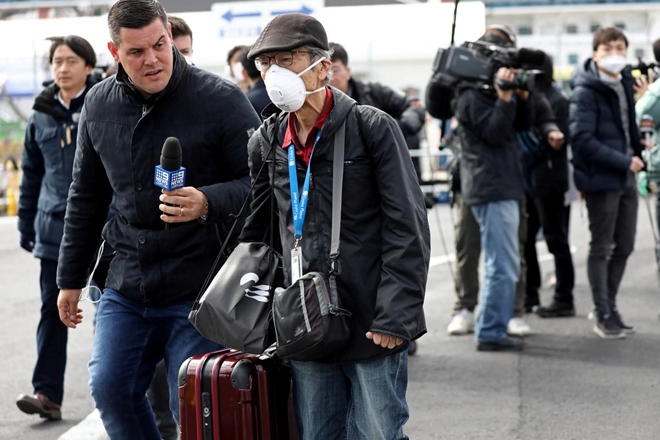Criticism of Japan's effort on coronavirus cruise ship as passengers leave
 |
|
A member of the media approaches a passenger after he walked out from the cruise ship Diamond Princess at Daikoku Pier Cruise Terminal in Yokohama, south of Tokyo, Japan February 19, 2020. REUTERS/Athit Perawongmetha |
The death toll from the coronavirus in mainland China passed 2,000 but the number of new cases there fell for a second straight day, offering a sliver of hope and helping Asian shares and U.S. stock futures rise.
China, the world’s second-largest economy, is struggling to get its manufacturing sector back on track after imposing severe travel restrictions to contain a virus that emerged in the central province of Hubei late last year.
In Japan, hundreds of people disembarked from the British-flagged Diamond Princess cruise liner docked at Yokohama near Tokyo, ending an ordeal that began when the ship was quarantined on Feb. 3 after a former passenger was diagnosed with the virus in Hong Kong.
“I am very keen to get off this ship,” Australian passenger Vicki Presland told Reuters over a social-media link. She was among a group of Australians getting off to catch an evacuation flight back to 14 days of quarantine in the city of Darwin.
The outbreak on the liner, owned by Carnival Corp , resulted in the biggest concentration of new coronavirus infections outside China despite more than two weeks of quarantine for its approximately 3,700 passengers and crew on board.
As questions swirled over how the virus spread so readily on the ship, Health Minister Katsunobu Kato defended Japan’s efforts.
“Unfortunately, cases of infection have emerged, but we have to the extent possible taken appropriate steps to prevent serious cases, including sending infected people to hospital,” Kato said in a report by state broadcaster NHK.
The U.S. Centers for Disease Control and Prevention (CDC) said Japan’s efforts might have slowed down the virus but were not enough.
“CDC’s assessment is that it may not have been sufficient to prevent transmission among individuals on the ship,” it said in a statement.
QUESTIONS
Japan has repeatedly said its response to the outbreak on the ship has been appropriate.
The United States has flown home more than 300 American evacuees from the ship and other countries are queuing up to collect their citizens, including Australians.
Like Australia, the United States and other countries are making citizens spend 14 days in quarantine upon their return.
With Japan just months away from hosting the 2020 Olympic Games, critics say the government’s response has seemed more concerned with managing public perception than the outbreak.
From the start, experts raised questions about quarantine on the ship. Passengers weren’t confined to their rooms until Feb. 5. The day before, as officials screened them, onboard events continued, including dances, quiz games and an exercise class, one passenger said.
Only passengers who test negative and do not show symptoms are being allowed to leave the ship. Those who have tested negative but were in cabins with infected people would remain on board for additional quarantine, Japanese officials said.
BETTER DAY IN CHINA
The promising sign out of China came from the National Health Commission, which reported the lowest daily rise in new infections since Jan. 29, or 1,749 new confirmed cases. Hubei - the epicenter of the outbreak - reported the lowest number of new infections since Feb. 11.
The latest figures bring the total number of cases in China to more than 74,000 and the death toll to 2,004, three-quarters of which have occurred in Wuhan, Hubei’s provincial capital. Six people have died outside mainland China, including a new fatality announced on Wednesday in Hong Kong.
On top of tough steps taken to isolate Hubei, where the flu-like virus originated in a market illegally selling wildlife, state media reported the province would track down anyone who visited doctors with fever since Jan. 20 or bought over-the-counter cough and fever medication.
Chinese officials have said the apparent slowdown in infection rates is evidence that the strict measures are working but global health officials say it is too early to predict how the epidemic will play out.
The number of new cases in mainland China excluding Hubei has fallen for 15 days. The number of new infections outside Hubei totaled 56 on Feb. 18, down from a peak of 890 on Feb 3.
The World Health Organization’s emergencies program chief, Mike Ryan, said China had success with “putting out the fire” first in Hubei and ensuring that people returning to Beijing from the Lunar New Year holiday were monitored.
Chinese officials have been putting on a brave face saying the economic impact of the virus would be limited and short-term. President Xi Jinping said China could meet its 2020 economic targets, media reported.
Big manufacturing hubs on the coast are starting to loosen curbs on the movement of people and traffic while authorities prod factories to get back to work.

